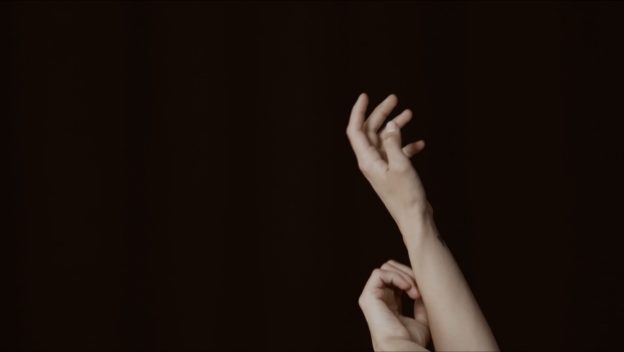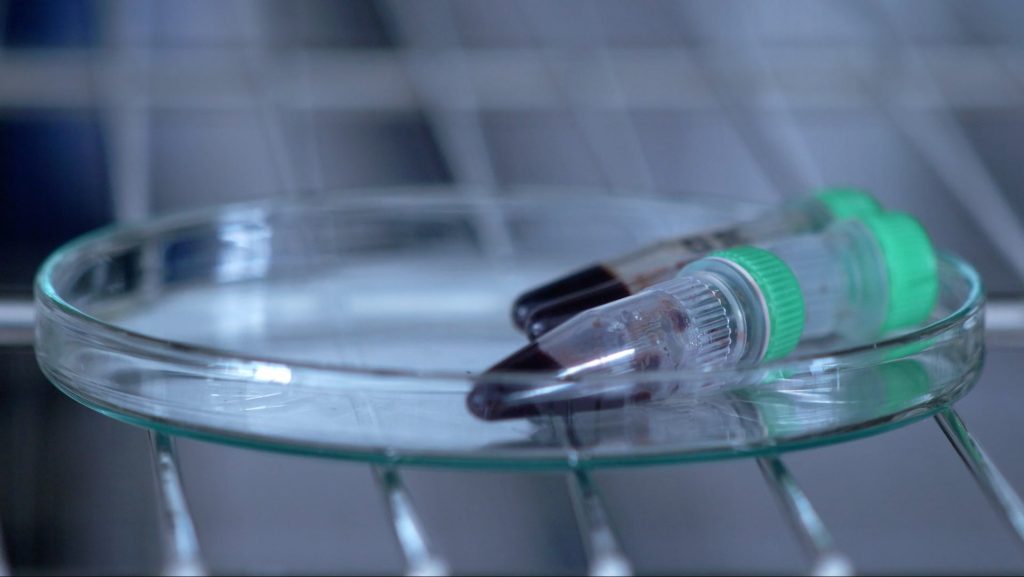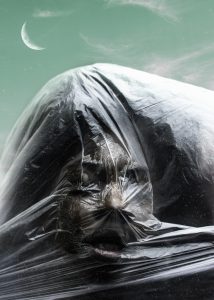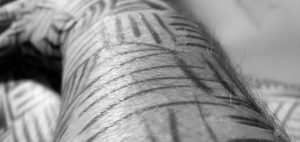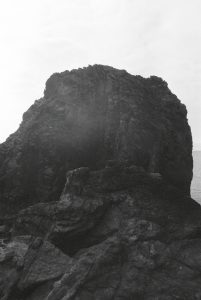with HYPERACUSIS (PART 1)
a film by SOPHIE HOYLE
CONTENT NOTE: This video contains footage of a scalpel incision into skin, a wound and blood being handled in a lab setting, as well as other images of medical equipment, such as scalpels, testing machines, and biological samples.
I like to joke with my friends at Stillpoint Magazine that I pilfer my personal life to write these editorial statements. I take the raw material of my weaknesses and foibles, desires and indiscretions to try and give some emotional authenticity—a “hook”—to engage readers in what the editorials have truly become, that is, a multipart critique of contemporary life. And they’ve taken on a vaguely lyrical, obliquely theoretical tone as they offer an entry-way, a portal to the issue as a whole, and to the concept around which that issue is organized. My aim is to provide something relatable, yet not-too-personal; something quotable, yet not-too-domineering, something that makes you say “yeaah” with visceral recognition of this fucked-up world in which we find ourselves.
Yet again we selected the concept for Issue 009: TENDER around the time of a particularly juicy personal mishap, which has become my greatest loss to date. And what I’ve come to realize is that what’s gone forever is not limited to the particulars; what’s gone forever is a fantasy I’d held on to tighter than I knew: me and my life? We are like this.
Turns out, I was wrong.
And that lost dream, like so many of the losses experienced since March 2020 by those I love or admire—and like many of the losses articulated in the artworks and texts that follow—leaves a wound, the kind that will never heal. Tender indeed.
As at a loss as I am, at the moment, for poetry, I’ll still attempt that pilfered element of lyricized emotional authenticity, that “hook” I mentioned above: Tender, I’ve been a somnambulist in a liminal antechamber, the purgatorial waiting-room of indecision, doubt, and fear. Tender, I’ve been a wound myself: ugly to see, painful to the touch, seeking succor and care from grifters and placebos that only seem to make the damage worse. With my darling fantasy of self and life lost forever, I’m left waiting, clinging now only to a question: “What remains?”
I offer myself here not (I hope) for narcissistic exhibitionism, but instead as a metaphor, an example of that ambivalence we find in TENDER itself, since tender is the place where delicacy, adoration, and care—of the child or the mother, of the lover, of the self—collides with the painful crush of power imposed, of guilt, of loss and grief. Illness, death, abuse, false seduction, the universal-yet-overlooked aggression between the mother and child. There are many tender times that bloom gorgeous, bloody blossoms into a life.
What, indeed, remains?
Here comes the moment when I’ll offer you the final element that has become a common trait of Stillpoint Magazine editorials. That is, a theoretical kernel, a concept that is ancillary or unconscious to that central concept—TENDER. This second concept is something I seek to produce in a flash of inspiration, after months of analytic development. It doesn’t always work, but what I’m looking for in the readings and studies that have found their way, variously, into the issue as a whole, is an antidote, or a hidden truth, a suggestion, or a warning to that notion from which we started. And in this case, armed only with my tender wound, and with my question of “What remains?” I find only humility. So, with few other resources to share, I’ll call here for humility. From this place of purgatorial drifting let me venture: embraced, humility can be a surrender to the impossibility of well-planned futures. Embraced, humility reveals the impossibility of lives well-ordered and organized, healthy, perfect. Embraced, humility reveals the impossibility of certain ends at all.
In this issue you’ll find: poetry on the tender pain of domestic violence as seen from the eyes of a son by Ojo Taiye, alongside a performance embodying indecision and loss by Indira Allegra. You’ll find poetry on childbirth, family, and the delicacy of new life by Lehua Taitano, and dreaming, screaming, dying-to-be-heard operatic video performance from Rieko Whitfield. You’ll find a raucous argument for the transformation of flirtation against dating-apps by Luce deLire, with The Stroker, a two-part video work experimenting with bodies under social pressure by Pilvi Takala. From Vanessa Sinclair you’ll find a psychoanalytic take on the reverberations of power and submission begun in the formative first relationship, alongside a second intimate video work from Sophie Hoyle, exploring the intersections of structural and cultural symbols of violence. You’ll also find a fashion editorial which celebrates the visceral, fragile, wild tenderness of motherhood. And you’ll find notes from the field by Jen Asturias, arguing for the need to deeply analyze gender and power in the work of advocacy for survivors of sexual and domestic violence.
HYPERACUSIS (PART 1)
More of Sophie Hoyle’s work is featured alongside an essay by Vanessa Sinclair elsewhere in Issue 009: TENDER here.
Hyperacusis (2021) is a two-channel film installation exploring mental health and trauma, access to healthcare, transcultural psychiatry, and the intergenerational impacts of racism, colonialism, and other socioeconomic inequalities. It includes a dance collaboration with French artist Jule Lanoix, interviews with psychiatrist/film-maker Khaldoon Ahmed, musician and writer Blue Maignien, and artist, DJ, teacher and musician Chooc Ly Tan. Experiments took place at UrsuLAB, a biohacking lab based at Antre Peaux, founded by Kina Madno (Quimera Rosa).
Part 1 of Hyperacusis is displayed here. The films were originally made as part of an EMAP/EMARE residency at Antre Peaux, Bourges in 2021.
– Sophie Hoyle
ANNE MARIE WIRTH CAUCHON editor
Anne Marie Wirth Cauchon is Editor-in-Chief of Stillpoint Magazine, and Creative Director of the PrairieCare Institute’s Center for Applied Psychoanalysis, the mother of two, a PhD candidate in English and Comparative Literature at the University of Minnesota, and the author of the novel Nothing.
SOPHIE HOYLE artist
Sophie Hoyle is an artist and writer whose work relates personal experiences of being queer, non-binary, disabled, and part of the MENA (Middle East and North Africa) diaspora to wider forms of structural violence. From lived experience of chronic health conditions including trauma, or Post-Traumatic Stress Disorder, they began to explore the politics of healthcare and history of biomedical technologies, which often overlaps with the histories of state and military surveillance and control.
Recent projects include Psychic Refuge (2021), a research project exploring mental health, trauma and its treatment in Palestine (OPT); Perspectives on Visibility: Hypervigilantes (2021), a collaborative film produced by Access, Power, Visibility collective (Arjun Harrison-Mann, Benjamin Redgrove, and Kaiya Waerea); and Hyperacusis (2021), two films made as part of a EMARE/EMAP residency at Antre Peaux, Bourges.
© Copyright for all texts published in Stillpoint Magazine are held by the authors thereof, and for all visual artworks by the visual artists thereof, effective from the year of publication. Stillpoint Magazine holds copyright to all additional images, branding, design and supplementary texts across stillpointmag.org as well as in additional social media profiles, digital platforms and print materials. All rights reserved.
